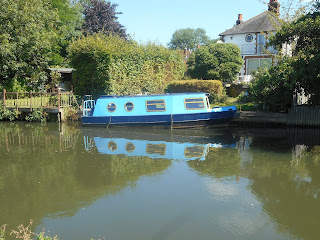The word "navigations" refers to the fact that the river, once impassable, was made navigable in the 17th and 18th centuries by canalizing large sections of it, and building a number of locks.
The navigations allowed barges carrying chalk, charcoal, timber, and other materials to move freely around rapids and shallows and ply their trade along the Wey, down to its junction with the Thames at Weybridge, and on to London. Below is a barge loaded with what appears to be chalk.
The increased trade greatly improved the local economy. The success of the navigations helped to inspire the building of many canals throughout Britain in the late 18th and early 19th centuries. The canal age is long over, of course, and nowadays, most of the Wey traffic, both on the water and along the old towpaths, is recreational. It is possible to take a horse-drawn canal boat from Godalming along much of this stretch of the Wey. For adetailed history of the navigations and more, see The Wey Valley
[For a detailed history of the Wey Navigations and much more, see http://www.weyriver.co.uk/theriver/nav_1_intro.htm
Our walk began at Guildford Station. From there to the Wey and is about a 15 minute walk. We were surprisingly soon in open countryside. The scene below is taken from the towpath on the outskirts of Guildford.
One of our most surprising discoveries was a couple of pillboxes, built in 1940 to defend against an anticipated Nazi invasion.
We came across the above while making a diversion at Broadford Bridge along the old Wey and Arun Canal to nearby Chinthurst Hill. It is topped by the folly below, built in the 1930s to look like a ruined medieval tower. It was an excellent spot for lunch and a rest with fine views of the surrounding hills and valleys.
This fellow, who we saw on our way up (and down) the hill, agreed with us on the rest part.
We were also treated to other displays of nature along the Wey.
We ended our walk in the pretty market town of Godalming, which is famous, among other things, for having hosted Czar Peter the Great at a town hotel during a visit to England in 1698. Among other things, Peter had come to learn about English shipbuilding.
Of course, we couldn't resist stopping at The Star, an award-winning pub with an amazing selection of ciders and perries.
For information on walks along the Wey, see Walk This Wey.



















No comments:
Post a Comment